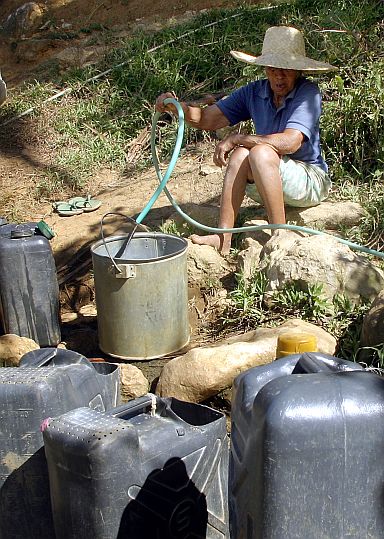
Juanita Ople, 76, waits to fill her bucket with water in a water source in Barangay Sirao in this file photo. (CDN PHOTO/JUNJIE MENDOZA)
IT IS not just heat strokes that the public needs to guard against in this time of high climatic temperature and low water supply.
Poor hygiene brought about by water shortage could lead to skin diseases like scabies, fungal infections and conjunctivitis, more commonly known as sore eyes.
Rennan Cimafranca, chief of the Regional Epidemiology and Surveillance (RESU-7) urged local government units to address the water problem brought about by the long dry spell or the El Niño phenomenon.
“Water is a basic necessity. Wash and bath regularly,” Cimafranca reminded the public.
“Less hygiene can cause discomfort. This (hygiene) is very important. We encourage the local government units to address the water problem,” Cimafranca told Cebu Daily News.
Concomitantly, prolonged exposure to heat can also cause heat strokes.
“This is not just a matter of how high the temperature or the heat index is; you’re more vulnerable when there’s prolonged exposure,” he added
Dr. Joanri Riveral, Medical Officer II of the Department of Health in Region 7 also advises public to drink more than eight glasses of water everyday to prevent dehydration.
“If you’re thirsty then drink water, avoid dehydration,,” Dr. Riveral said.
Those who are more vulnerable to heat strokes are the elderly and those who have heart disease and other health concerns.
He also advised people to stay in well ventilated places.
SYMPTOMS
Symptoms of heat stroke include sweating, intense thirst, dizziness, fainting, weakness, and high blood pressure.
On the other hand, skin diseases like scabies is manifested by itching and small red spots caused by an itch mite and can be contagious through close personal contact.
Fungal infections as defined by Bupa Health Information Directory is caused by different types of fungi and can be a common culprit of itchy skin.
These include athlete’s foot, jock itch, ringworm, and yeast infections.
Conjunctivitis is manifested with redness and inflammation of the membranes covering the whites of the eyes and the membranes in the inner part of the eyelids.
WATER SUPPLY
The Metropolitan Cebu Water District (MCWD) has already identified 45 areas in Metro Cebu which have interior and elevated connections that either have low water pressure or no water at all because water systems have dried up due to El Niño.
Even ground water sources and bulk water supplies are affected.
There is a 20,000-cubic-meter deficit in water supply broken down to 10,000 cubic meters from the Buhisan Dam, 7,000 cubic meters from the Jaclupan facility and 3,000 cubic meters from bulk suppliers.